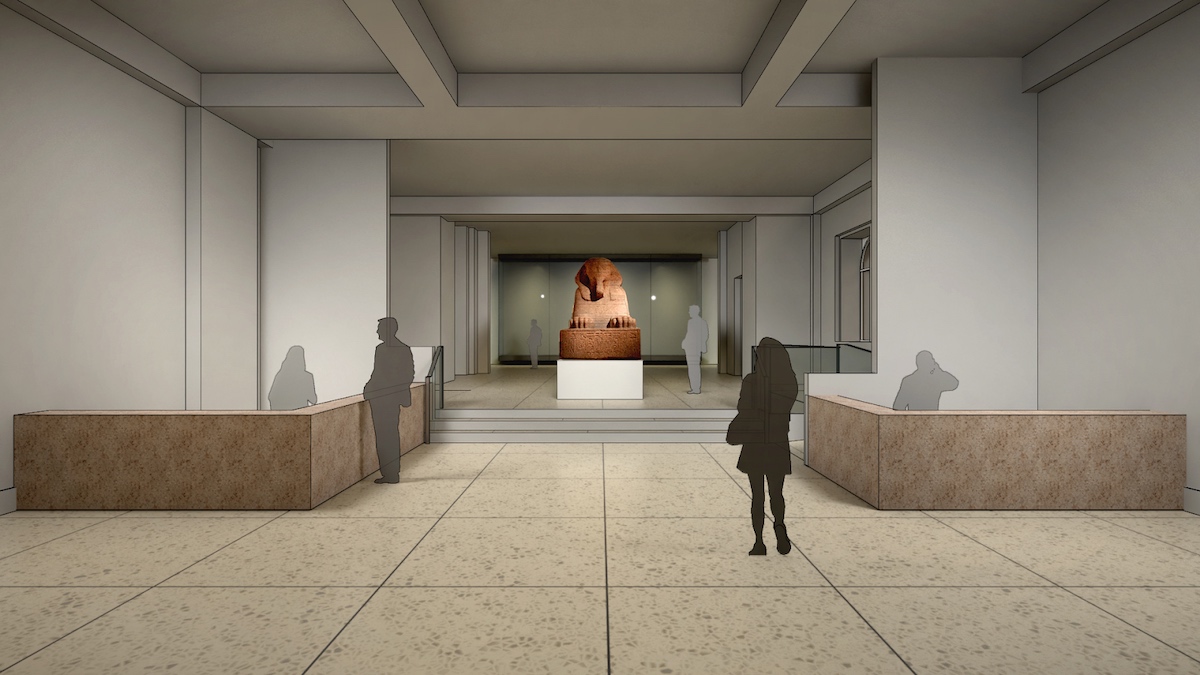Penn Museum has never undertaken anything like this, said Chief Building Engineer Brian Houghton as he stood on the wooden walkway above the Mosaic Courtyard.
The museum is moving its 3,000-year-old Sphinx of Ramses II — ancient Egypt’s third Pharaoh of the 19th dynasty — out of the Egypt (Sphinx) Gallery this week to its new permanent home in the Main Entrance Hall. The structure is the largest sphinx in the Western Hemisphere, at 25,000 pounds.
To make it happen, the museum had some construction to start: An L-shaped walkway about eight to 15 feet high and five feet wide was built in the courtyard to provide a route for the sphinx. Doorways and windows were removed to make an opening out of the Egypt (Sphinx) Gallery, onto the walkway and into the Main Entrance Hall, which opens on Nov. 16 after renovations.
About eight months ago, the museum decided to pursue moving the sphinx so it could be the centerpiece of the new entrance hall, Houghton said, and the project was approved two months later. Structural engineers determined the sphinx’s route and sections of the floor that needed to be redesigned to handle the sphinx’s weight.
On Monday, riggers used a gantry crane and chain falls to lift up the Sphinx from its platform and onto the floor. For the rigging and transport, the museum 3-D scanned the Sphinx to find out its height, weight, density and any cavities in the statue, Houghton said.
On Tuesday, the Sphinx was placed onto a scaffold with four air-powered dollies under each corner. Like a hoverboard, the Sphinx will float about three to four inches above the ground with the help of an air compressor generator pushing pressure into the dollies through four hoses.
An operator will control the generator while an eight-person crew tends to the hoses and pushes the Sphinx along until they make it into the Main Entrance Hall and chain the Sphinx up again to place it on the floor.
All this for a mere 250 feet of distance between the two spaces.

A view of the ramp where the sphinx will travel between its old and new home from above. (Courtesy photo)
Houghton said his main concern is avoiding any pinch points between the statue and the walkway’s railing where someone could get their fingers caught.
“This thing can move,” he said. “I mean, readily move. Somebody can put too much pressure on one side, the right side, or left side.”
The museum is using winch cables to help keep the statue straight, he added.
The move is open to the public, and up to 25 visitors can watch from the museum’s bridge overlooking the courtyard. There will also be time lapses of the move here and here.
The sphinx hasn’t been exposed to natural light since it was moved to the Egypt (Sphinx) Gallery in 1926. For about four hours, more or less, it will catch some Philadelphia sun on the way to its new home.
See the orange "air-dollies" underneath the 25,000 pound Sphinx? Today they were put in place for the #MonumentalMove. More updates soon! #MoveTheSphinx pic.twitter.com/IXkFyb4o6G
— Penn Museum (@pennmuseum) June 10, 2019
Before you go...
Please consider supporting Technical.ly to keep our independent journalism strong. Unlike most business-focused media outlets, we don’t have a paywall. Instead, we count on your personal and organizational support.
Join our growing Slack community
Join 5,000 tech professionals and entrepreneurs in our community Slack today!

The person charged in the UnitedHealthcare CEO shooting had a ton of tech connections

From rejection to innovation: How I built a tool to beat AI hiring algorithms at their own game

How a laid-off AI enthusiast pivoted to become a founder — while holding down a day job


